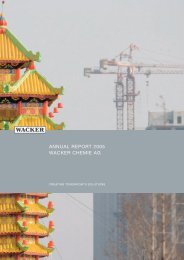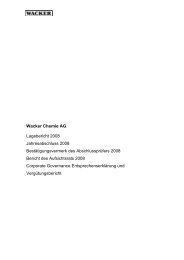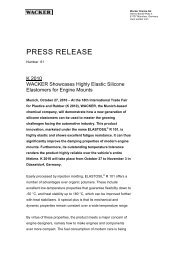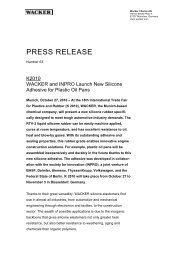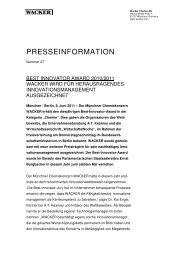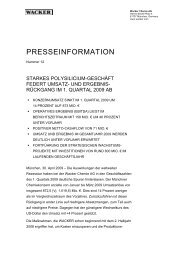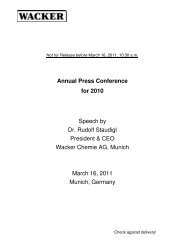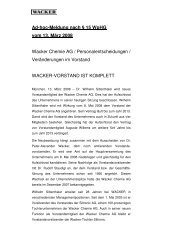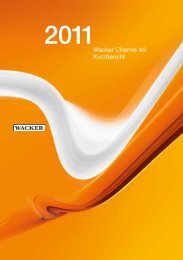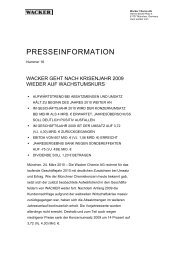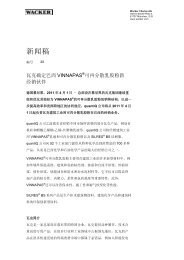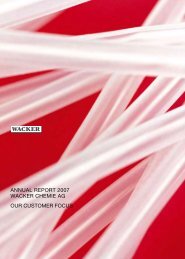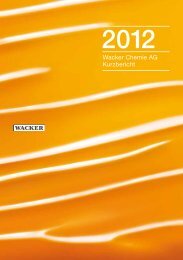powersil ® (pdf | 2.3 mb) - Wacker Chemie
powersil ® (pdf | 2.3 mb) - Wacker Chemie
powersil ® (pdf | 2.3 mb) - Wacker Chemie
You also want an ePaper? Increase the reach of your titles
YUMPU automatically turns print PDFs into web optimized ePapers that Google loves.
CREATING TOMORROW’S SOLUTIONS<br />
HIGH-pERfORMANCE SILICONES fOR<br />
TRANSMISSION ANd dISTRIbUTION
WACKER SILICONES<br />
STAND FOR OPERATIONAL SAFETY<br />
AND DURABILITY<br />
Thanks to their molecular structure,<br />
silicones are the perfect solution<br />
for insulating applications in the<br />
transmission and distribution sec-<br />
tor. For example, silicone composite<br />
insulators covered with pollution<br />
layers have much lower leakage<br />
currents than insulators made of<br />
porcelain, glass or EPDM. This<br />
prevents pollution flashovers, even<br />
if the surface is extremely dirty.<br />
However, not only insulators profit<br />
from silicones. Nowadays, silicone<br />
insulating materials are used in medium-<br />
and high-voltage applications<br />
wherever high operational safety and<br />
long service lives are required. For<br />
example, silicone fluid in transformers<br />
or silicone-elastomer terminations of<br />
high-voltage cables.<br />
POWERSIL <strong>®</strong> and ELASTOSIL <strong>®</strong> are registered<br />
trademarks of <strong>Wacker</strong> <strong>Chemie</strong> AG.<br />
50 Years of Research to Ensure<br />
Reliable Transmission Networks<br />
WACKER has been continuously<br />
researching new silicone products<br />
for more than five decades. The key<br />
focus used to be on the formulation<br />
itself, but now additional issues relating<br />
to production economics and<br />
environ mental protection have moved<br />
to the forefront. WACKER meets these<br />
stricter requirements with continuous<br />
developments and innovations.<br />
Leading Manufacturer of Silicones<br />
for Transmission and Distribution<br />
Applications<br />
With the POWERSIL <strong>®</strong> products,<br />
WACKER was the first silicone<br />
manufacturer to offer its customers<br />
a complete range of insulating and<br />
electrically conductive silicone rubber<br />
grades for medium- and high-voltage<br />
applications. Silicone products from<br />
WACKER have been used to make<br />
generations of insulators and other<br />
insulating components.<br />
Global Production –<br />
Local Customer Support<br />
The silicones that WACKER manufactures<br />
at its various production sites<br />
worldwide meet identical quality standards.<br />
What’s more, we have set up technical<br />
centers across the globe to offer all<br />
kind of support for product selection,<br />
manufacturing, and end-product specification.<br />
For more information, visit:<br />
www.wacker.com<br />
3
CONTENTS<br />
Chapter 1: WACKER Silicones Page 7<br />
1.1 Properties of Silicones<br />
1.2 Silicone Product Groups<br />
1.3 Overview of Applications<br />
1.4 Our Philosophy<br />
Chapter 2: Insulators / Insulator Coatings Page 19<br />
2.1 Long-Rod Insulators / Surge Arresters<br />
2.2 Hollow-Core Insulators<br />
<strong>2.3</strong> Insulator Coatings<br />
Chapter 3: Cable Accessories Page 27<br />
3.1 Cable Accessories<br />
3.2 Field Grading with Cable Accessories<br />
3.3 Cable Accessories: Silicone Products with Specifications<br />
Chapter 4: Insulating Materials Page 37<br />
4.1 Silicone Fluids<br />
4.2 Silicone Gels<br />
Chapter 5: Auxiliary Materials Page 41<br />
5.1 Adhesion Promoters / Insulator Finish / Adhesives /<br />
Mold Release Agents<br />
5.2 Sliding and Filling Pastes<br />
Chapter 6: Processing Technologies Page 45<br />
6.1 Injection Molding<br />
6.2 Low-Pressure Mold Filling<br />
6.3 Extrusion<br />
Innovations Page 50<br />
WACKER at a Glance Page 51<br />
5
ChAPTER 1:<br />
WACKER SILICONES<br />
Contents<br />
1.1 Properties of Silicones Page 8<br />
General characteristics of silicones, the role of their<br />
molecular structure, and the key properties for<br />
individual applications.<br />
1.2 Silicone Product Groups Page 12<br />
Properties of the individual silicone product groups<br />
(elastomers, gels and fluids).<br />
1.3 Typical Applications for Silicones Page 14<br />
Typical applications for silicones, their key properties<br />
and their advantages over conventional insulating materials.<br />
1.4 Our Philosophy Page 16<br />
The high standards that WACKER products<br />
must meet; how customers benefit.<br />
7<br />
WACKER SILICONES
1.1 PROPERTIES OF SILICONES<br />
Thanks to their chemical structure,<br />
silicones are extremely suitable for<br />
applications in the transmission<br />
and distribution sector. They have<br />
an impressive spectrum of electrical,<br />
physical, mechanical and<br />
chemical properties.<br />
Hydrophobicity<br />
Compared to other materials, silicones<br />
exhibit very good, long-lasting<br />
water-repellency, also known as hydrophobicity.<br />
Insulating components<br />
made of silicone rubber compounds<br />
still repel water after many years. The<br />
leakage current is minimized and thus<br />
pollution flashover is prevented. This<br />
also applies to very dirty surfaces,<br />
because the water-repelling effect is<br />
transferred to the pollution layer. This<br />
is known as hydrophobicity transfer.<br />
Such an effect can also be achieved<br />
by treating glass and porcelain insulators<br />
with a silicone coating, making<br />
repeated cleaning processes unnecessary.<br />
8<br />
Resistance to UV Radiation and<br />
Weathering<br />
Compared to other materials, silicone<br />
elastomers are particularly resistant to<br />
UV radiation. Even harsh weather conditions,<br />
as found in coastal regions<br />
or deserts, have little effect on their<br />
properties. For example, in an accelerated<br />
weathering test, the silicone<br />
rubber POWERSIL <strong>®</strong> 310 showed only<br />
slight changes in the mechanical and<br />
hydrophobic properties after 3,000<br />
hours.<br />
Low Flammability<br />
Silicones only ignite at very high<br />
temperatures. This makes them<br />
particularly safe in operation. Even if<br />
they did ever catch fire, they would<br />
not produce any toxic gases. This is<br />
why they are the ideal choice for applications<br />
subject to strict fire safety<br />
requirements, for example in subways<br />
and high-rise buildings.<br />
Elasticity<br />
Silicone insulating materials are<br />
extremely elastic. This facilitates<br />
installation and makes for novel<br />
installation techniques, e.g. cold<br />
shrinking on cables.<br />
Dielectric Properties<br />
Silicones have high electrical resistivity<br />
and a low dielectric loss factor.<br />
They exhibit extremely low electrical<br />
aging compared to other insulating<br />
materials.<br />
Temperature Stability<br />
Owing to their chemical structure,<br />
silicones have particularly high ther -<br />
mal stability. Another benefit of silicones<br />
is their high temperature resistance.<br />
For example, silicones maintain<br />
their elasticity down to -45 °C, which<br />
makes them particularly suitable for<br />
use at high altitudes and in polar<br />
regions.
1.1 PROPERTIES OF SILICONES<br />
PROPERTIES AT A GLANCE<br />
Water Repellency (Hydrophobicity)<br />
Water cannot spread out on silicones;<br />
pollution layers turn hydrophobic due<br />
to the hydrophobicity transfer effect.<br />
Resistance to UV Radiation<br />
The stability of the Si-O backbone<br />
makes silicones permanently resistant<br />
to the UV portion of solar radiation.<br />
Low Flammability<br />
Silicones only ignite at very high temperatures.<br />
In case of fire, they do not release any<br />
toxic or corrosive products.<br />
Elasticity<br />
In contrast to other elastomers, silicone<br />
elastomers have an above-average and<br />
permanent elasticity. They maintain their<br />
elasticity down to -45 °C.<br />
Dielectric Properties<br />
Silicone insulating materials have a low<br />
dielectric loss factor, very high electrical<br />
resistivity, and high dielectric strength<br />
that remains stable over a long period.<br />
Stability at High Temperature<br />
WACKER SILICONES<br />
Property Advantages for Transmission and<br />
Distribution Technology<br />
Silicones have long-term thermal stability,<br />
even in the presence of atmospheric oxygen.<br />
Reliability<br />
Minimizes the risk of pollution flashovers<br />
in the case of dirty surfaces and thus provides<br />
considerably greater safety compared to<br />
conventional insulating materials.<br />
Outdoor Applicability<br />
Ideally suited to outdoor applications.<br />
Outstanding Fire Safety<br />
Perfect suitability for use in locations with strict<br />
fire safety requirements, e.g. in high-rise buildings,<br />
locomotives, ships, hospitals and subways.<br />
Large Temperature Range<br />
The components can be installed at low<br />
temperatures. No loss of elasticity during<br />
long-term use at very high or very low<br />
temperatures.<br />
Longer Service Life<br />
Significantly slower electrical aging and<br />
thus a significantly longer service life than<br />
other insulating materials under the<br />
same conditions.<br />
Higher Utilization<br />
They can operate at higher temperatures<br />
than other insulating materials, allowing better<br />
utilization of transformer capacity.<br />
9<br />
WACKER SILICONES
1.1 PROPERTIES OF SILICONES<br />
KEY PROPERTIES<br />
Property Relevance with Regard to the Applications<br />
Silicone fluids<br />
for modern<br />
transformers<br />
10<br />
Hydro-<br />
phobicity<br />
Resistance to<br />
UV Radiation<br />
Processing<br />
Properties of<br />
Low-Viscosity<br />
Silicone<br />
Elastomers<br />
Low<br />
Flammability<br />
Permanent<br />
Elasticity<br />
Dielectric<br />
Properties<br />
Temperature<br />
Resistance<br />
● ● ●<br />
Cable joints ● ●<br />
Cable terminations ● ● ● ● ●<br />
Arresters ● ● ●<br />
Composite hollowcore<br />
insulators<br />
Composite long-rod<br />
insulators<br />
Insulator coatings ●<br />
● = Key property ● = Further important property<br />
Silicone insulating components<br />
have been used in transmission<br />
networks for more than 50 years.<br />
For each new application, silicones<br />
were chosen as the insulating material<br />
for a variety of reasons.<br />
Key Properties for Electrical<br />
Applications<br />
Over the last 50 years, silicones have<br />
gained acceptance in many fields<br />
of the transmission and distribution<br />
industry. Each new application<br />
required a different key property, even<br />
if the already known advantages were<br />
also desirable. In the case of insulator<br />
coatings, the original focus was solely<br />
on the water-repelling effect of the<br />
● ● ● ●<br />
● ● ●<br />
silicones. In subsequently developed<br />
insulators, the high UV resistance of<br />
silicone elastomers was an additional<br />
advantage. The key properties for<br />
individual applications have remained<br />
largely the same. One exception is<br />
transformer fluids. Originally, the main<br />
focus was on their low flammability,<br />
but now the emphasis is on their<br />
temperature resistance.
1.1 PROPERTIES OF SILICONES<br />
MOLECULAR STRUCTURE<br />
OF SILICONES<br />
The excellent stability and high formulation<br />
flexibility of silicones arise<br />
from the basic chemical structure.<br />
This is the major advantage of silicones,<br />
and the reason why they are<br />
superior to other materials.<br />
Exceptional Stability<br />
Silicones, called polyorganosilioxanes<br />
by chemists, have a similar structure<br />
to organically modified quartz. They<br />
consist of a backbone comprising<br />
alternating silicon and oxygen atoms.<br />
The high bonding energy of the silicon-<br />
oxygen backbone (Si-O) gives silicones<br />
a high stability. Thus silicones<br />
are more stable than polymers with<br />
a carbon (C-C) backbone, such as<br />
EPDM. The energy of C-C bonds is<br />
348 kJ/mol, as op posed to 444 kJ/<br />
mol for Si-O bonds. Shortwave sunlight<br />
(300 nm) has an energy content<br />
of about 6.2 × 10 -22 kJ (= 398 kJ/mol)<br />
and can therefore cleave C-C bonds,<br />
whereas the Si-O bond remains<br />
stable.<br />
Chemical Structure of a Linear Silicone Polymer<br />
O<br />
CH 3<br />
CH 3<br />
Si<br />
CH 3<br />
Si<br />
Tailored to Your Electrical Application<br />
WACKER specialists have more than<br />
50 years of experience with silicone<br />
insulating materials for transmission<br />
networks. They de velop silicones<br />
CH 3<br />
The silicon-oxygen backbone makes<br />
silicones very stable.<br />
tailored to meet your application and<br />
processing technology requirements as<br />
well as local guidelines. Please contact<br />
your WACKER specialist.<br />
O<br />
O<br />
CH 3<br />
Si<br />
CH 3<br />
O<br />
O<br />
Si<br />
CH 3<br />
O<br />
CH 3<br />
Si<br />
CH 3<br />
CH 3<br />
11<br />
WACKER SILICONES
1.2 SILICONE PRODUCT GROUPS<br />
Elastomers<br />
Silicone elastomers and silicone coatings<br />
are the most important group of<br />
silicone products in the transmission<br />
and distribution sector. Owing to the<br />
wide range of potential applications,<br />
they are always under ongoing development.<br />
Silicone polymers are the raw materials<br />
for manufacturing silicone elastomers.<br />
Elastomers differ with respect<br />
to their viscosity and curing system.<br />
Whereas insulating components used<br />
to be made of RTV-2 silicone rubbers<br />
by casting, nowadays, there is a trend<br />
toward new technologies.<br />
12<br />
Silicone Gels<br />
Silicone gels are a special group of<br />
insulating materials. They can replace<br />
liquids or elastomers, depending on<br />
the application. Silicone gels pose less<br />
risk of leakages than fluids.<br />
Silicone gels can fill hollow spaces<br />
perfectly, even those with a complicated<br />
shape. They adhere excellently<br />
to the interior walls of components.<br />
Silicone gels are usually low-viscosity,<br />
2-component products. By using<br />
special fillers, it’s possible to produce<br />
compressible and modified gels.<br />
Silicone Fluids<br />
Silicone fluids have proven to be<br />
excellent coolants and insulating<br />
materials in modern transformers.<br />
Owing to their outstanding temperature<br />
resistance, new applications for<br />
which requirements are similarly strict<br />
may be expected. A further important<br />
application field for silicone fluids are<br />
high-voltage cable accessories.<br />
Silicone fluids are linear polymers with<br />
a chain length ranging from two to well<br />
over 1,000 Si atoms. The silicon atoms<br />
alternate with bridging oxygen atoms.
Overview of Silicone Rubbers<br />
Silicone Rubber Mixing Ratio Silicone<br />
Product Family<br />
Low-viscosity, 9 :1 RTV-2 Low-pressure<br />
2-component<br />
mold filling<br />
rubber<br />
(casting)<br />
Low-viscosity,<br />
2-component<br />
liquid rubber<br />
2-component<br />
liquid rubber<br />
Solid rubber,<br />
1-component<br />
RTV = Room-Temperature-Curing (Vulcanizing)<br />
POWERSIL <strong>®</strong> XLR <strong>®</strong> = Extra Liquid Rubber<br />
LSR = Liquid Silicone Rubber<br />
HCR = high Consistency Rubber<br />
Processing Properties<br />
1:1 POWERSIL <strong>®</strong> XLR <strong>®</strong> Low-pressure<br />
mold filling with<br />
mixing and dosing<br />
equipment<br />
1:1 LSR Injection<br />
molding<br />
– HCR Injection<br />
molding<br />
• Good electrical properties<br />
• Good mechanical properties<br />
• Simple production technologies<br />
• Ideal co<strong>mb</strong>ination of electrical and mechanical<br />
properties<br />
• Potential for further developments in processing<br />
machinery<br />
• Excellent mechanical properties<br />
• Extensive product range available, including,<br />
for example, grades modified to be electrically<br />
conductive and grades for outdoor applications<br />
• Potential for new developments and modifications<br />
• Wide product range for various processing<br />
technologies, such as injection molding and extrusion<br />
• Grades modified to be electrically conductive and<br />
grades for outdoor applications<br />
• Wide variety of modification options with respect to<br />
the curing process, color, and other properties<br />
13<br />
WACKER SILICONES
1.3 TYPICAL APPLICATIONS<br />
FOR SILICONES<br />
Application Silicone<br />
Product Family<br />
Coating of insulators<br />
(and other insulating components)<br />
>> Page 24 – 25<br />
Long-rod composite insulators<br />
with a silicone elastomer sheath<br />
>> Page 20 – 21<br />
Composite hollow-core insulators<br />
with a silicone elastomer sheath<br />
>> Page 22 – 23<br />
Surge arresters<br />
>> Page 20 – 21<br />
Cable terminations<br />
>> Page 28 – 35<br />
Cable joints<br />
>> Page 28 – 35<br />
Applications for silicone gels<br />
>> Page 39<br />
Transformer fluid<br />
>> Page 38<br />
Key Property Benefits Compared to<br />
Conventional Insulating Materials<br />
• RTV-1 Hydrophobicity • Low leakage current<br />
• Higher pollution-flashover voltage<br />
• Lower maintenance costs<br />
• Longer service life<br />
• HCR<br />
• RTV-2<br />
• LSR<br />
• HCR<br />
• RTV-2<br />
• LSR<br />
• HCR<br />
• RTV-2<br />
• LSR<br />
• HCR<br />
• RTV-2<br />
• LSR<br />
• HCR<br />
• RTV-2<br />
• LSR<br />
Resistance to UV radiation • Low leakage current<br />
• Higher pollution-flashover voltage<br />
• Lower maintenance costs<br />
• Longer service life<br />
Resistance to UV radiation<br />
+ processing properties<br />
Reliability with respect to overloading<br />
and low flammability<br />
• Low leakage current<br />
• Higher pollution-flashover voltage<br />
• Lower maintenance costs<br />
• Longer service life<br />
• Greater safety<br />
Permanent elasticity • Longer service life<br />
• Lower or no maintenance costs<br />
Stability of the important electrical<br />
and mechanical properties in the<br />
temperature range of the applications<br />
• Silicone gels Leakage protection and interphase<br />
behavior<br />
• Silicone fluids Thermal resistance and<br />
low flammability<br />
• Longer service life,<br />
• Lower or no maintenance costs<br />
• Greater environmental safety<br />
• Highest flame resistance<br />
15<br />
WACKER SILICONES
1.4 OUR PhILOSOPhY:<br />
MORE LOCAL PRESENCE,<br />
hIGhER QUALITY<br />
Benefit from WACKER’s Silicone<br />
Experts and Their Know-How<br />
We’ll gladly share our research results<br />
with you. Whether providing advice<br />
on process engineering or helping<br />
you to create new applications – your<br />
WACKER customer advisor looks forward<br />
to working with you.<br />
WACKER Technical Centers<br />
Across the globe, our state-of-the-art<br />
technical centers are fo cused on finding<br />
the best solution for each customer –<br />
whether they need pro duct modifica-<br />
tions or optimized formulations, have<br />
questions about processing, or need<br />
help with tests to comply with particular<br />
standards.<br />
16<br />
Local presence is already reality<br />
at WACKER. Over the decades,<br />
we have developed many silicone<br />
products in close cooperation<br />
with our customers.<br />
Tailored Silicone Products<br />
Specialists at WACKER develop<br />
solutions tailored to market requirements.<br />
We focus on<br />
• Optimizing mechanical and electrical<br />
properties, such as tracking and<br />
erosion resistance<br />
• Optimizing products for customers’<br />
manufacturing processes<br />
• Compliance with international<br />
standards<br />
Diverse Test Procedures<br />
WACKER has laboratories around<br />
the globe that can test silicone elastomers<br />
according to current standard<br />
test procedures. WACKER provides<br />
comprehensive application engineering<br />
and research resources for the<br />
development of new test procedures.<br />
Recently, WACKER silicone specialists<br />
participated in the development of<br />
several new test procedures, including<br />
methods of assessing hydrophobicity<br />
and of investigating and evaluating the<br />
stability of the electrical conductivity<br />
of carbon-black-filled silicone elastomers.<br />
Another new field of research<br />
relates to methods of evaluating the<br />
electrical strength of silicone elastomers.
Participation in International<br />
Committees<br />
Specialists from WACKER participate<br />
in many international committees and<br />
working groups. These include the<br />
Deutsche Elektrotechnische Kommission<br />
(DKE), the Conseil International<br />
des Grands Réseaux Électriques<br />
(CIGRE), and the International Electrotechnical<br />
Commission (IEC). Wherever<br />
possible, WACKER takes on work in<br />
standardization committees in the<br />
interests of its customers.<br />
Utilization of the Latest Research<br />
Findings<br />
Our own silicone research department<br />
at WACKER provides customers with<br />
access to the latest scientific findings<br />
and technologies.<br />
Globally Certified Manufacturing<br />
Processes<br />
The manufacture of WACKER silicone<br />
products is regulated by globally certified<br />
processes. This guarantees the<br />
processing company a continuously<br />
consistent quality.<br />
WACKER Technical Center (Technikum)<br />
Our Technical Center (Technikum) offers<br />
modern production facilities suitable for<br />
both extrusion and injection molding,<br />
where we can test prototypes and new<br />
products. Plus, we will advise you at<br />
your premises.<br />
WACKER ACADEMY<br />
At the WACKER ACADEMY, we share<br />
our more than 80 years of market experience<br />
with you, from basic chemistry<br />
to regionally tailored training courses<br />
on applications, and innovation workshops<br />
– we provide a platform that promotes<br />
networking and allows people<br />
to showcase their skills.<br />
17<br />
WACKER SILICONES
ChAPTER 2:<br />
INSULATORS /<br />
INSULATOR COATINGS<br />
Contents<br />
2.1 Long-Rod Insulators / Surge Arresters Page 20<br />
How silicones benefit long-rod insulators and<br />
surge arresters; the factors important to production.<br />
2.2 Hollow-Core Insulators Page 22<br />
Why silicones are preferred for hollow-core insulators;<br />
suitable production processes and silicone grades.<br />
<strong>2.3</strong> Silicone Coatings for Insulators Page 24<br />
Why the silicone-coating method is important to cost-efficient<br />
insulator maintenance; suitable silicone grades.<br />
19<br />
INSULATORS /<br />
INSULATOR COATINGS
2.1 LONG-ROD INSULATORS /<br />
SURGE ARRESTERS<br />
Silicone long-rod insulators are<br />
used from 10 kV to 1,000 kV, for<br />
example as suspension and tension<br />
insulators or post and railway<br />
insulators.<br />
20<br />
Advantages of Using Silicones in<br />
Long-Rod Insulators<br />
Silicones have been used in longrod<br />
insulators for more than 50 years<br />
on account of their high weathering<br />
resistance and good tracking and<br />
erosion resistance. Further advantages<br />
include:<br />
• Long service life<br />
POWERSIL <strong>®</strong> silicone rubbers have<br />
excellent hydrophobic properties<br />
and outstanding resistance to temperature,<br />
UV radiation and ozone.<br />
• Low weight<br />
Long-rod insulators weigh up to<br />
80 percent less than conventional<br />
porcelain and glass insulators. This<br />
facilitates installation in challenging<br />
locations, for example in mountainous<br />
regions.<br />
• Good impact and shock<br />
resistance<br />
The flexibility of silicone insulat-<br />
ing materials reduces the risk of<br />
breakage during transport and<br />
installation. Failure as the result of<br />
vandalism is rare.<br />
• High flashover resistance<br />
at high pollution<br />
The surface hydrophobicity of<br />
silicones provides long-lasting<br />
protection against leakage currents<br />
and flashovers, even if the surface<br />
is very dirty. In such situations, this<br />
increases the reliability of the power<br />
supply, for example in industrial,<br />
coastal and desert regions and for<br />
railways.<br />
• Low maintenance costs<br />
Due to the transfer of hydrophobic<br />
properties, the water-repelling effect<br />
is maintained even if the surface is<br />
dirty, which means that the insulators<br />
do not need regular cleaning.
Design Principle of a Long-Rod Insulator<br />
Fitting<br />
Manufacture and Processing of<br />
Long-Rod Insulators<br />
These insulating parts are produced<br />
by applying a silicone housing onto<br />
the glass-fiber-reinforced epoxy<br />
resin or the active part of the surge<br />
arrester.<br />
Silicone housing<br />
Adhesion promoter<br />
• Manufacturing process<br />
Injection molding, low-pressure<br />
filling of the mold (casting), modular<br />
“shed by shed” process<br />
• Grades<br />
The choice of product – POWERSIL <strong>®</strong><br />
solid silicone rubber (HCR), extraliquid<br />
systems (POWERSIL <strong>®</strong> XLR <strong>®</strong> )<br />
or LSR – depends on the manufacturing<br />
process.<br />
Composite GRP silicone elastomer<br />
long-rod insulator: the insulating<br />
materials’ beneficial properties<br />
complement each other perfectly<br />
in a lightweight, durable and thus<br />
environmentally sound product.<br />
Core of glass-fiber-<br />
reinforced plastic<br />
(GRP)<br />
21<br />
INSULATORS /<br />
INSULATOR COATINGS
2.2 hOLLOW-CORE INSULATORS<br />
Hollow-core insulators are used for<br />
arresters, bushings, and instrument<br />
transformers at high voltages of<br />
up to 1,000 kV. State-of-the-art<br />
production processes permit diameters<br />
up to one meter in size, and<br />
lengths of several meters.<br />
22<br />
Advantages of Using Silicones in<br />
Hollow-Core Insulators<br />
• Reliable production process<br />
The low-pressure molding process<br />
produces silicone hollow-core insulators<br />
with considerable reliability<br />
and flexibility, making products<br />
available on demand.<br />
• Good handling due to<br />
low weight<br />
Hollow-core insulators are up to 80<br />
percent lighter than conventional<br />
porcelain insulators. This facilitates<br />
transport and installation in<br />
challenging locations.<br />
• Good impact and shock<br />
resistance<br />
The flexibility of silicone insulating<br />
materials reduces the risk of breakage<br />
during transport, installation<br />
and earthquakes.<br />
• High flashover resistance of<br />
polluted surfaces<br />
The surface hydrophobicity of silicones<br />
provides long-lasting protection<br />
against tracking currents, and<br />
thus against flashovers, even if the<br />
surface is highly polluted and wet.<br />
Silicone Rubber for Insulators<br />
Silicone Processing<br />
Insulating HCR Injection molding<br />
Insulating HCR Extrusion<br />
Insulating LSR Injection molding<br />
Insulating LSR Low-pressure mold filling<br />
Insulating RTV-2 Low-pressure mold filling<br />
Silicone Gel Casting
Manufacture and Processing of<br />
Hollow-Core Insulators<br />
Hollow-core insulators are made of<br />
glass-fiber-reinforced resin tubes that<br />
are housed using silicone rubber:<br />
• Manufacturing process<br />
Low-pressure filling of the mold<br />
(casting), extrusion<br />
• Grades<br />
The choice of product – POWERSIL <strong>®</strong><br />
room-temperature-vulcanizing systems<br />
(RTV-2), low-viscosity LSR and<br />
POWERSIL <strong>®</strong> XLR <strong>®</strong> systems or a<br />
special solid silicone rubber (HCR) –<br />
depends on the manufacturing<br />
process.<br />
Material Hardness<br />
Shore A<br />
ISO 868<br />
Design Principle of a Hollow-Core Insulator<br />
Elongation<br />
at Break<br />
[%]<br />
ISO 37<br />
Tear<br />
Strength<br />
[N/mm]<br />
ISO 37<br />
Tracking<br />
Resistance<br />
IEC 60587<br />
Glass-fiber-reinforced<br />
resin tube<br />
Adhesion promoter<br />
Silicone housing<br />
Aluminum flange<br />
Viscosity<br />
[mPa s]<br />
Shear Rate<br />
10 s -1<br />
Volume<br />
Resistivity<br />
IEC60093<br />
[Ωcm]<br />
POWERSIL <strong>®</strong> 310 C6/C8 70 250 16 1 A 4.5 – >10 14 1.55<br />
POWERSIL <strong>®</strong> 3100 70 400 18 1 A 4.5 – >10 14 1.52<br />
POWERSIL <strong>®</strong> 3500 45 800 28 1 A 3.5 – >10 15 1.13<br />
POWERSIL <strong>®</strong> 3101 75 300 15 1 A 4.5 – >10 14 1.58<br />
POWERSIL <strong>®</strong> 310 E2 72 200 14 1 A 4.5 – >10 14 1.55<br />
POWERSIL <strong>®</strong> 730 35 600 25 1 A 4.5 150,000 >10 15 1.09<br />
POWERSIL <strong>®</strong> 735 39 550 30 1 A 4.5 130,000 >10 15 1.08<br />
POWERSIL <strong>®</strong> XLR <strong>®</strong> 630 36 450 25 1 A 4.5 12,000 >10 15 1.14<br />
POWERSIL <strong>®</strong> XLR <strong>®</strong> 640 40 450 23 1 A 4.5 40,000 >10 15 1.13<br />
POWERSIL <strong>®</strong> 600 30 500 25 1 A 3.5 15,000 >10 15 1.13<br />
POWERSIL <strong>®</strong> Gel Gel – – – 1,000 >10 15 0.97<br />
POWERSIL <strong>®</strong> Gel FC (fast cure) Gel – – – 1,000 >10 15 0.97<br />
POWERSIL <strong>®</strong> Gel C 670 (compressible) Gel – – – 4,000 >10 15 0.70<br />
Density<br />
ISO 2781<br />
[g/cm 3 ]<br />
23<br />
INSULATORS /<br />
INSULATOR COATINGS
<strong>2.3</strong> SILICONE COATINGS FOR<br />
INSULATORS<br />
Silicone Coating as Turn-Key Solution<br />
through WACKER Partners<br />
Silicone coatings are usually sold as a<br />
complete turn-key solution package<br />
covering supply and application.<br />
WACKER works with experienced<br />
specialists who will provide both the<br />
materials and the coating services.<br />
Your WACKER consultant can give you<br />
further guidance in this respect.<br />
24<br />
The risk of conventional insulators<br />
failing increases with the rate of<br />
pollution. Insulators can be made<br />
operationally reliable again by<br />
giving them a subsequent silicone<br />
coating.<br />
Improved Electrical Properties<br />
A pollution layer on insulators made<br />
of porcelain, glass, or epoxy resin<br />
can cause pollution flashovers.<br />
This hazard can be prevented by<br />
regular cleaning. However, a more<br />
cost-effective and long-term alternative<br />
is a hydrophobic silicone coating<br />
on the insulator.<br />
A silicone coating improves the<br />
electric properties, even on aged<br />
epoxy resin insulators, outdoor testing<br />
equipment and antenna systems.<br />
Some manufacturers of porcelain and<br />
glass insulators have recently started<br />
to promote the application of silicone<br />
coatings (also in the factory) to make<br />
their products water repellent.<br />
Silicone Insulator Coatings from WACKER<br />
Silicone Material Color Density<br />
(Cured)<br />
[g/cm3 ]<br />
1,000 h<br />
Salt-Fog-Test<br />
acc. to IEC<br />
62217<br />
RTV-1 POWERSIL <strong>®</strong> 552 Dark gray 1.44 Passed<br />
RTV-1 POWERSIL <strong>®</strong> 567 Light gray 1.10 Passed<br />
RTV-1 POWERSIL <strong>®</strong> 570 PLUS 1 Light gray 1.10 Passed<br />
1 POWERSIL <strong>®</strong> 570 PLUS represents a silicone-in-water emulsion and does not contain any hydrocarbon solvents.
Advantages of Silicone Coatings<br />
on Insulators<br />
• Higher operational reliability<br />
Low leakage current measured in<br />
microamps is the norm due to the<br />
outstanding hydrophobic properties.<br />
Pollution flashovers can thus<br />
be avoided, even if the surface is<br />
very dirty or even wet.<br />
• Retrofitting of existing<br />
installations<br />
Silicone coatings offer a cost-effective<br />
option for hydrophobic coating<br />
of insulators made of porcelain,<br />
glass, or epoxy resin. This saves<br />
the costs for periodic cleaning or<br />
for a replacement with composite<br />
insulators.<br />
• Longer service life<br />
Silicone coatings lengthen the service<br />
life of existing installations, thus<br />
contributing to effective resource<br />
management. Experience has<br />
shown that the service life of silicone<br />
coatings is 15 years or more.<br />
Processing of Silicone Coatings<br />
POWERSIL <strong>®</strong> silicone coatings are<br />
delivered ready-to-use; however, before<br />
they are filled into the processing<br />
machine, they should be thoroughly<br />
stirred whilst still in their packaging.<br />
POWERSIL <strong>®</strong> insulator coatings are<br />
usually processed using so-called<br />
airless me<strong>mb</strong>rane equipment, as is<br />
used for high-quality paintwork.<br />
The surfaces being coated should<br />
be thoroughly cleaned beforehand<br />
to ensure good adhesion to the<br />
substrate.<br />
The application of silicone coatings is<br />
as important as the coating itself and<br />
requires well developed controlled<br />
procedures and expertise.<br />
Initial Hydrophobicity<br />
Water droplet on a<br />
porcelain surface.<br />
Transfer of Hydrophobic Properties<br />
Water droplet on a<br />
clean silicone surface.<br />
Stable Hydrophobic Properties<br />
Water droplet on a<br />
dirty silicone coating.<br />
Water droplet on a<br />
silicone-coated surface.<br />
Water droplet on a<br />
dirty silicone surface.<br />
Water droplet on a<br />
cleaned silicone coating.<br />
25<br />
INSULATORS /<br />
INSULATOR COATINGS
ChAPTER 3:<br />
CABLE ACCESSORIES<br />
Contents<br />
3.1 Cable Accessories Page 28<br />
Why silicone cable accessories ensure permanently<br />
secure connections; which production processes<br />
are available.<br />
3.2 Field Grading with Cable Accessories Page 30<br />
How to grade the electrical field using<br />
WACKER’s specialty silicone rubber; which<br />
individual grades are available.<br />
3.3 Cable Accessories: Silicone Products<br />
with Specifications Page 32<br />
All the important silicone grades for the production<br />
of cable accessories; their main properties and<br />
technical specifications.<br />
27<br />
CABLE ACCESSORIES
3.1 CABLE ACCESSORIES<br />
28<br />
Cable accessories are used<br />
outdoors and in the ground. This<br />
requires outstanding insulating<br />
properties. In addition, slip-on<br />
and cold-shrink accessories must<br />
be highly elastic if connections<br />
are to be permanently secure.<br />
WACKER silicone rubbers have<br />
been meeting these requirements<br />
perfectly for many years.<br />
Application Fields for Cable<br />
Accessories<br />
Cable joints, terminations and connectors<br />
made of WACKER silicone<br />
elastomers are used worldwide for<br />
voltages ranging from 10 kV to above<br />
500 kV. Low-voltage joints can be<br />
economically filled with silicone gel,<br />
which does not require classification<br />
as a hazardous substance.<br />
Advantages of WACKER Silicone<br />
Elastomers for Cable Accessories<br />
• Long service life<br />
WACKER silicone rubbers have<br />
excellent hydrophobic properties<br />
and outstanding resistance to temperature,<br />
UV radiation and ozone.<br />
Thanks to their excellent long-term<br />
electrical behavior, they are perfect<br />
insulating materials for cable accessories.<br />
There is hardly any aging<br />
due to the effects of an electric<br />
field alone.<br />
• High operational reliability<br />
WACKER silicone rubbers show<br />
very good tracking and arc resistance.<br />
They also have a high flashover<br />
resistance, even if the surface<br />
is very dirty.<br />
• Permanent elasticity<br />
Cable accessories made of silicone<br />
elastomers are highly and permanently<br />
elastic over a wide temperature<br />
range.
Design Principle of a Cold-Shrinkable Cable Joint<br />
Outer semicon layer<br />
Manufacture of Cable Accessories<br />
WACKER silicone rubbers are suit -<br />
able for both slip-on and cold-shrink<br />
tech nology. The choice of product –<br />
solid silicone rubbers (HCR), liquid<br />
silicone rubbers (LSR), extra-liquid<br />
systems (POWERSIL <strong>®</strong> XLR <strong>®</strong> ), or roomtemperature-vulcanizing<br />
systems<br />
(RTV-2) – depends on the manufacturing<br />
process.<br />
Field control<br />
electrode<br />
Insulating silicone Cable insulation<br />
Conductor<br />
Thanks to the favorable stress /<br />
elongation ratio and the outstanding<br />
resilience, the insulating element<br />
fits perfect on the cable wires without<br />
any gaps. The electrical insulation is<br />
permanently maintained.<br />
Support core<br />
29<br />
CABLE ACCESSORIES
3.2 FIELD GRADING WITh<br />
CABLE ACCESSORIES<br />
Using special silicone elastomers<br />
from WACKER, the electrical field<br />
strength within the cable joints,<br />
terminations and connectors can<br />
be efficiently graded to reduce<br />
localized, high field strengths.<br />
30<br />
Field Grading with<br />
WACKER Silicone Rubbers<br />
For field grading applications,<br />
WACKER offers a wide range of high<br />
permittivity grades and grades that<br />
have been modified to be electrically<br />
conductive. The electric field can be<br />
graded geometrically or refractively:<br />
• Geometric field grading is carried<br />
out with specially shaped conductive<br />
electrodes (deflectors) that usually<br />
have a volume resistivity of less<br />
than 100 Ωcm. The outer conducting<br />
layer of the cable is continued<br />
inside the accessory.<br />
• Refractive field grading is based on<br />
the deflection of field lines at the<br />
interface between materials with a<br />
different permittivity. Silicone elastomers<br />
with a high relative per mittivity<br />
are used in such cases. Particularly<br />
suitable grades have a high permittivity<br />
ranging from 10 to 30, depending<br />
on the grade.<br />
Electrically Conductive Silicone<br />
Dispersions<br />
An electrically conductive coating<br />
on cable joints and connectors ensures<br />
high operational reliability and<br />
a long service life for the products.<br />
For coat ing applications, WACKER<br />
has a series of electrically conductive<br />
silicone dispersions, including<br />
POWERSIL <strong>®</strong> 402, which can also<br />
be used as an adhesion-promoting<br />
primer, e.g. for deflectors.
Design Principle of a Cable Termination<br />
Fitting<br />
Cable conductor<br />
Cable insulation<br />
Insulating silicone<br />
Electrically conductive silicone<br />
Electrically conductive<br />
outer cable layer<br />
Cable shielding<br />
Outer cable jacket<br />
Perfect field grading is required<br />
in order to reduce the electric field<br />
strength at the end of the outer<br />
conductive layer of the cable.<br />
Special silicone rubbers have<br />
properties that can be used to<br />
grade electric fields.<br />
31<br />
CABLE ACCESSORIES
3.3 CABLE ACCESSORIES:<br />
SILICONE PRODUCTS AND<br />
PROPERTIES (hCR)<br />
Silicone Processing Material Hardness<br />
Shore A<br />
ISO 868<br />
32<br />
Elongation<br />
at Break<br />
[%]<br />
ISO 37<br />
Insulating HCR Injection molding POWERSIL <strong>®</strong> 351 38 800 30<br />
Electrically Conductive<br />
HCR<br />
HCR with a High<br />
Dielectric Constant<br />
POWERSIL <strong>®</strong> 352 45 700 25<br />
POWERSIL <strong>®</strong> 3525 23 1,100 30<br />
POWERSIL <strong>®</strong> 3500 45 800 28<br />
POWERSIL <strong>®</strong> 3540 38 900 28<br />
Tear<br />
Strength<br />
[N/mm]<br />
ISO 37<br />
ELASTOSIL <strong>®</strong> R 401 10 – 90 300 – 1,200 17 – 26<br />
ELASTOSIL <strong>®</strong> R 420 30 –70 550 – 1,000 25 – 40<br />
Injection molding ELASTOSIL <strong>®</strong> R 570/50 50 310 10<br />
POWERSIL <strong>®</strong> 440 43 500 15<br />
POWERSIL <strong>®</strong> 448 50 350 12<br />
Injection molding POWERSIL <strong>®</strong> 415 38 400 20<br />
Insulating HCR Extrusion ELASTOSIL <strong>®</strong> R plus 4305/40 40 900 35<br />
Electrically Conductive<br />
HCR<br />
HCR with a High<br />
Dielectric Constant<br />
ELASTOSIL <strong>®</strong> R plus 4110/40 40 900 35<br />
Extrusion ELASTOSIL <strong>®</strong> R plus 573/50 50 350 12<br />
POWERSIL <strong>®</strong> 448 50 350 12<br />
Extrusion POWERSIL <strong>®</strong> 412 54 280 10
Tracking<br />
Resistance<br />
IEC 60587<br />
Viscosity<br />
[mPa s]<br />
Shear Rate 10 s -1<br />
Volume<br />
Resistivity<br />
IEC60093<br />
[Ωcm]<br />
Density<br />
ISO 2781<br />
[g/cm 3 ]<br />
Main Properties<br />
1 A 3.5 – >10 15 1.10 High tracking resistance, excellent mechanical properties<br />
1 A 3.5 – >10 15 1.13 High tracking resistance, low tension set<br />
1 A 3.5 – >10 15 1.09 High tracking resistance, excellent mechanical properties,<br />
fast-curing 1-component system<br />
1 A 3.5 – >10 15 1.13 High tracking resistance, excellent mechanical properties,<br />
fast-curing 1-component system<br />
1 A 3.5 – >10 15 1.11 High tracking resistance, excellent mechanical properties,<br />
fast-curing 1-component system<br />
1 A 2.5 – >10 15 1.12 – 1.19 Standard grade<br />
1 A 2.5 – >10 15 1.09 – 1.19 Standard grade with excellent mechanical properties<br />
– – 5 1.11 Standard grade with excellent electrical conductivity<br />
– – 30 1.11 Good mechanical properties, low tension set<br />
– – 10 1.14 Fast-curing 1-component system; electrically conductive<br />
– – 10 10<br />
(εr = 15)<br />
1.30<br />
High permittivity; εr ≈ 15<br />
1 A 2.5 – >10 15 1.09 Outstanding mechanical properties<br />
1 A 2.5 – >10 15 1.10 Excellent mechanical properties, fast-curing 1-component system<br />
– – 5 1.13 Very good electrical conductivity, fast-curing system for extrusion<br />
– – 10 1.14 Fast-curing 1-component system, electrically conductive<br />
– – 10 10<br />
(εr = 28)<br />
1.34<br />
High permittivity; εr ≈ 28<br />
33<br />
CABLE ACCESSORIES
3.3 CABLE ACCESSORIES:<br />
SILICONE PRODUCTS AND PROP-<br />
ERTIES (LSR AND AUXILIARIES)<br />
Silicone Processing Material Hardness<br />
Shore A<br />
ISO 868<br />
34<br />
Elongation<br />
at Break<br />
[%]<br />
ISO 37<br />
Insulating LSR Injection molding POWERSIL <strong>®</strong> 730 35 600 25<br />
Electrically<br />
Conductive LSR<br />
Insulating LSR Low-pressure<br />
mold filling<br />
Electrically<br />
Conductive LSR<br />
POWERSIL <strong>®</strong> 732 CS 32 740 35<br />
POWERSIL <strong>®</strong> 735 39 550 30<br />
POWERSIL <strong>®</strong> 740 43 650 38<br />
Tear<br />
Strength<br />
[N/mm]<br />
ISO 37<br />
ELASTOSIL <strong>®</strong> LR 3003 5 – 80 300 – 700 7 – 35<br />
ELASTOSIL <strong>®</strong> LR 3003/30 CS 32 720 28<br />
ELASTOSIL <strong>®</strong> LR 3043 30 – 70 450 – 690 30 – 45<br />
Injection molding POWERSIL <strong>®</strong> 464 52 280 20<br />
Low-pressure<br />
mold filling<br />
POWERSIL <strong>®</strong> 466 38 650 25<br />
POWERSIL <strong>®</strong> 466 LV 36 650 25<br />
POWERSIL <strong>®</strong> 735 39 550 30<br />
POWERSIL <strong>®</strong> XLR <strong>®</strong> 620 33 425 15<br />
ELASTOSIL <strong>®</strong> LR 3002/35 33 450 25<br />
POWERSIL <strong>®</strong> 464 52 280 20<br />
Insulating RTV-2 Casting POWERSIL <strong>®</strong> 600 30 500 25<br />
Electrically Conductive<br />
Silicone Dispersion<br />
Spraying POWERSIL <strong>®</strong> 402 – – –<br />
POWERSIL <strong>®</strong> 420 – – –<br />
POWERSIL <strong>®</strong> 79032 – – –<br />
Silicone Lubricants POWERSIL <strong>®</strong> PASTE AP – – –<br />
POWERSIL <strong>®</strong> PASTE AF – – –<br />
PASTE P 250 – – –<br />
PASTE P 300 – – –<br />
Silicone Gel Casting POWERSIL <strong>®</strong> Gel Gel – –<br />
POWERSIL <strong>®</strong> Gel FC Gel – –<br />
POWERSIL <strong>®</strong> Gel C 670 Gel – –
Tracking<br />
Resistance<br />
IEC 60587<br />
Viscosity<br />
[mPa s]<br />
Shear Rate 10 s -1<br />
Volume<br />
Resistivity<br />
IEC60093<br />
[Ωcm]<br />
Density<br />
ISO 2781<br />
[g/cm 3 ]<br />
Main Properties<br />
1 A 4.5 150,000 >10 15 1.09 High tracking resistance, very good mechanical properties<br />
1 A 4.5 320,000 >10 15 1.11 High tracking resistance, excellent mechanical properties,<br />
optimized for cold-shrink accessories<br />
1 A 4.5 130,000 >10 15 1.08 High tracking resistance, very good mechanical properties<br />
1 A 4.5 540,000 >10 15 1.14 High tracking resistance, excellent mechanical properties<br />
1 A 2.5 25,000 – 540,000 >10 15 1.05 – 1.19 Standard grade with very good mechanical properties<br />
1 A 2.5 200,000 >10 15 1.11 Highly elastic grade for cold-shrink technology<br />
1 A 2.5 320,000 – 630,000 >10 15 1.10 – 1.14 Standard grade with excellent mechanical properties<br />
– 400,000 70 1.10 RTV-2 adheres well to overmolded POWERSIL <strong>®</strong> 464<br />
– 550,000 40 1.11 Excellent mechanical properties<br />
– 400,000 40 1.11 Excellent mechanical properties, low viscosity<br />
1 A 4.5 130,000 >10 15 1.08 High tracking resistance, very good mechanical properties<br />
1 A 4.5 15,000 >10 15 1.10 High tracking resistance, very low viscosity<br />
1 A 2.5 70,000 >10 15 1.09 Very good mechanical properties<br />
– 400,000 70 1.10 RTV-2 adheres well to overmolded POWERSIL <strong>®</strong> 464<br />
1 A 3.5 15,000 >10 15 1.13 High tracking resistance, very low viscosity<br />
– 5 1.22 Volume resistivity 5 Ωcm<br />
– 0.5 1.24 Volume resistivity 0.5 Ωcm<br />
– 5 1.22 Volume resistivity 5 Ωcm, 1-component material<br />
– 1.02 Very good lubricating properties, no swelling of silicone<br />
elastomers in contact with the paste<br />
– 1.33 Very good lubricating properties, no swelling of silicone<br />
elastomers in contact with the paste<br />
– 0.98 Good insulating electrical properties, good adhesion to metals<br />
and ceramic materials, excellent water repellency<br />
– 0.94 Good insulating electrical properties, good adhesion to metals<br />
and ceramic materials, excellent water repellency<br />
– 1,000 >10 15 0.97 Very low viscosity, excellent adhesion<br />
– 1,000 >10 15 0.97 Very low viscosity, excellent adhesion, fast curing<br />
– 4,000 >10 15 0.70 Compressible<br />
35<br />
CABLE ACCESSORIES
ChAPTER 4:<br />
INSULATING MATERIALS<br />
Contents<br />
4.1 Silicone Fluids Page 38<br />
Why silicone fluids are preferred for heat dissipation<br />
in modern transformers; their relevant properties.<br />
4.2 Silicone Gels Page 39<br />
The characteristics and benefits of silicone gel<br />
as a potting compound.<br />
37<br />
INSULATING MATERIALS
4.1 SILICONE FLUIDS<br />
Modern transformers generate a<br />
lot of heat during operation.<br />
Silicone fluids have proven to be<br />
excellent coolants and dielectrics.<br />
High-voltage cable terminations<br />
are another important application<br />
field for silicone fluids.<br />
Composition and Properties<br />
Silicone fluids used for electrical<br />
in sulation are typically poly(dimethylsil<br />
oxanes). They are transparent,<br />
color less and odorless liquids. Their<br />
molar mass ranges from 1,000 to<br />
150,000 g/mol. They have viscosities<br />
ranging from 0.65 to 1,000,000 mm²/s,<br />
and continuous operating temperatures<br />
ranging from the pour point<br />
(-60 °C to -40 °C, depending on the<br />
viscosity) to about 180 °C.<br />
Temperature changes have little effect<br />
on the key properties of silicone fluids,<br />
for example the dielectric loss factor<br />
and the viscosity. This distinguishes<br />
them from other electrical insulating<br />
fluids such as mineral oils and<br />
ester fluids. Special grades have an<br />
extended application range that includes<br />
lower and higher temperatures<br />
(-100 °C to +250 °C).<br />
38<br />
1 POWERSIL <strong>®</strong> Fluid TR 20: > 270 °C<br />
The Classic Solution for<br />
Transformers<br />
Marketed under the name POWERSIL <strong>®</strong><br />
Fluid, WACKER offers silicone fluids<br />
that have been specially optimized for<br />
insulation systems in modern highperformance<br />
transformers. Although<br />
they were originally developed to<br />
replace PCB, POWERSIL <strong>®</strong> Fluid TR<br />
50 and POWERSIL <strong>®</strong> Fluid TR 20 are<br />
now used mainly on account of their<br />
excellent resistance to oxidation and<br />
their high flash point. A special feature<br />
of the silicone fluids is that they exhibit<br />
only a moderate increase in viscosity<br />
at low temperatures.<br />
Silicone Fluid for High Energy<br />
Densities<br />
WACKER developed POWERSIL <strong>®</strong><br />
Fluid TR 20 for applications in which<br />
large amounts of heat have to be dissipated<br />
in a short time. The product<br />
has a very low viscosity of 20 mm 2 per<br />
second. It has a flash point of 240 °C<br />
and an ignition point of 270 °C. In addition,<br />
POWERSIL <strong>®</strong> Fluid TR 20 has<br />
an excellent cold-start capability. Its<br />
pour point is below -50 °C, which is a<br />
decisive advantage in wind turbines.<br />
Advantages of Silicone Fluids<br />
• High temperature resistance<br />
• Extremely low dielectric loss factor<br />
• Only minor changes in the electrical<br />
properties over a wide temperature range<br />
• High flash point<br />
Product Properties of POWERSIL <strong>®</strong> Fluid TR 50 and POWERSIL <strong>®</strong> Fluid TR 20<br />
Typical General Characteristics Inspection Method Properties<br />
Density at 20 °C ISO 3675 0.96 g/cm 3<br />
Viscosity, kinematic at 40 °C ISO 3104 40 mm 2 /s<br />
Flash point ISO 2719 > 240 °C<br />
Fire point ISO 2592 > 340 °C 1<br />
Pour point ISO 3016 < -50 °C<br />
Neutralizing value IEC 60836 < 0.01 mg KOH/g<br />
Breakdown voltage IEC 60156 > 40 kV<br />
Dissipation factor tan at 90 °C<br />
and 50 Hz<br />
IEC 60247 < 0.001<br />
Permittivity at 90 °C and 50 Hz IEC 60247 2.55 (+/- 0.05)<br />
Volume resistivity 90 °C IEC 60247 < 10 13 Ω cm (>100 GΩm)
4.2 SILICONE GELS<br />
Silicone gels are used as insulating<br />
potting compounds, e.g. for cable<br />
accessories.<br />
Properties<br />
Silicone gels are pourable, additioncuring,<br />
two-component silicones.<br />
Silicone gels do not cure to a silicone<br />
elastomer in the conventional sense,<br />
but to soft, gel-like products. The<br />
components of POWERSIL <strong>®</strong> Gels have<br />
a very low viscosity with excellent<br />
pouring properties. The cured si li-<br />
cone pretty much adheres to all substrates<br />
in contact with the gel. It also<br />
has excellent dielectric properties.<br />
Special fillers allow the modification<br />
of gels. WACKER offers a compressible<br />
gel that can be used to fill gaps in<br />
electrical equipment.<br />
Advantages of Silicone Gels<br />
• High electric strength<br />
• Low modulus<br />
• Low viscosity<br />
Product Properties of POWERSIL <strong>®</strong> Gels<br />
Processing Material Viscosity [mPa s]<br />
Shear Rate 10 s -1<br />
Volume Resistivity<br />
IEC60093 [Ωcm]<br />
Density<br />
ISO 2781 [g/cm 3 ]<br />
Main Properties<br />
Casting POWERSIL <strong>®</strong> Gel 1,000 >10 15 0.97 Very low viscosity, excellent<br />
adhesion<br />
Casting POWERSIL <strong>®</strong> Gel FC 1,000 >10 15 0.97 Very low viscosity, excellent<br />
adhesion, fast curing<br />
Casting POWERSIL <strong>®</strong> Gel C 670 4,000 >10 15 0.70 Compressible<br />
39<br />
INSULATING MATERIALS
ChAPTER 5:<br />
AUXILIARY MATERIALS<br />
Contents<br />
5.1 Adhesion Promoters Page 42<br />
Why silicone-based adhesion promoters are the material<br />
of choice at particular times in particular instances.<br />
Insulator Finish Page 42<br />
Characteristics of WACKER finishing rubber.<br />
Adhesives Page 42<br />
Advantages of two-component silicone adhesives.<br />
Mold Release Agents Page 42<br />
Why industry prefers to use silicones as mold release<br />
agents; their typical properties.<br />
5.2 Sliding and Filling Pastes Page 43<br />
Properties of slip-on aids (such as silicone pastes)<br />
necessary for effective insulation.<br />
41<br />
AUXILIARY MATERIALS
5.1 ADhESION PROMOTERS /<br />
INSULATOR FINISh / ADhESIVES /<br />
MOLD RELEASE AGENTS<br />
Adhesion Promoters<br />
Insulating elements are made of different<br />
materials. Adhesion promoters<br />
are used to ensure a tightly sealed<br />
interphase.<br />
Grades<br />
• W A C K E R <strong>®</strong> Primer G 790 is recommended<br />
to promote adhesion between<br />
liquid rubbers (LSR) or RTV-2<br />
silicone rubbers and other materials,<br />
such as glass-fiber-reinforced<br />
plastics and metal fittings<br />
• W A C K E R <strong>®</strong> Primer G 791 promotes<br />
adhesion between vulcanized<br />
silicone rubber and another layer of<br />
RTV-2 or liquid silicone rubber<br />
• W A C K E R <strong>®</strong> Primer G 3243 is used<br />
to promote adhesion between<br />
peroxide-cured solid rubbers and<br />
other materials, such as glass-fiberreinforced<br />
plastics (GRP) or metal<br />
fittings<br />
• W A C K E R <strong>®</strong> Primer G 800 promotes<br />
adhesion between addition-curing<br />
solid rubbers and other materials<br />
• Electrically conductive POWERSIL <strong>®</strong><br />
402 primer may be used to promote<br />
adhesion of insulating RTV-2 and<br />
42<br />
liquid rubbers to silicone rubbers<br />
that have been modified to be electrically<br />
conductive.<br />
Advantages<br />
• Tested auxiliary products from a<br />
single source, in conjunction with<br />
the silicone rubbers, ensure reliable<br />
and safe use for the customer.<br />
• WACKER has its own range of adhesion<br />
promoters for all applications.<br />
Insulator Finish<br />
Insulator finish is used to mend small<br />
damaged areas and for subsequent<br />
filling of cavities. A self-curing silicone<br />
rubber is used for this.<br />
Grades<br />
• POWERSIL <strong>®</strong> INSULATOR FINISH<br />
Advantages<br />
• The product has a high tracking<br />
resistance<br />
• WACKER manufactures and<br />
supplies finishing rubber<br />
• Same color as POWERSIL <strong>®</strong> 310,<br />
POWERSIL <strong>®</strong> 3100,<br />
POWERSIL <strong>®</strong> XLR <strong>®</strong> 630 etc.<br />
Adhesives<br />
Two-component, heat-curing silicone<br />
adhesives are the perfect choice for<br />
quick joining of vulcanized silicone<br />
rubber components. Alternatively,<br />
cured silicone rubber parts can be<br />
joined by RTV-1 silicone rubber.<br />
Grades<br />
• ELASTOSIL <strong>®</strong> R 3113 A/B<br />
• ELASTOSIL <strong>®</strong> E 4<br />
• ELASTOSIL <strong>®</strong> E 43<br />
Mold Release Agents<br />
Mold release agents ensure an efficient<br />
production of molded parts.<br />
This is particularly important when<br />
using certain solid rubbers. External<br />
release agents also facilitate demolding<br />
when a new mold is being run in.<br />
Chemical Structure and Properties<br />
The surfactant structure of mold<br />
release agents for silicone rubber<br />
grades gives them their excellent<br />
release effect. A 1% aqueous solution<br />
is sprayed into the hot mold.<br />
Grades<br />
• ELASTOSIL <strong>®</strong> AUX<br />
mold release agent 32
5.2 SLIDING AND FILLING PASTES<br />
Sliding and Filling Pastes<br />
WACKER silicone pastes are designed<br />
as slip-on aids and lubricants for<br />
application in the field of medium- and<br />
high-voltage cable accessories. In<br />
addition to their excellent lubricating<br />
properties, WACKER silicone pastes<br />
exhibit good electrical properties<br />
and an excellent release effect with<br />
respect to elastomers and plastics.<br />
Furthermore, WACKER is the first<br />
manufacturer to present a completely<br />
boron-free paste portfolio.<br />
Chemical Structure and Properties<br />
Silicone pastes are composed of<br />
thermostable siloxanes and inorganic<br />
fillers. The exceptional properties of<br />
WACKER silicone pastes give them<br />
a very wide performance spectrum.<br />
Silicone pastes provide excellent<br />
electrical insulation, i.e. high dielectric<br />
strength and a low dielectric loss<br />
factor.<br />
Owing to their oxidation resistance,<br />
silicone pastes have long-term resistance<br />
to weathering. They can be used<br />
as lubricants, installation aids, sealants,<br />
release agents, dampening aids,<br />
heat sink pastes, moisture protection<br />
and much more. Due to their high water<br />
repellency, silicone pastes are used<br />
to e<strong>mb</strong>ed electrical equipment and<br />
protect it from moisture and corrosion.<br />
In the field of transmission and<br />
distribution, the main application of<br />
WACKER silicone pastes is for the<br />
installation of cable accessories like<br />
cable joints and terminations.<br />
Grades<br />
• POWERSIL <strong>®</strong> PASTE AP is an opaque<br />
to whitish paste of medium consistency<br />
that co<strong>mb</strong>ines the outstanding<br />
dielectric properties of a silicone<br />
paste with good lubricating and<br />
release properties. Due to its special<br />
formulation with phenyl-modified<br />
silicone oil, this paste causes no<br />
substantial swelling of silicone elastomers<br />
that come into contact with<br />
it. POWERSIL <strong>®</strong> PASTE AP is seen as<br />
the standard product for the asse<strong>mb</strong>ly<br />
of cable accessories and other<br />
parts in high- and medium-voltage<br />
technology.<br />
• POWERSIL <strong>®</strong> PASTE AF is an opaque<br />
to whitish paste of medium consistency<br />
that is based on a fluoro-silicone<br />
oil and therefore causes even less<br />
swelling of silicone elastomers in<br />
contact with the paste. POWERSIL <strong>®</strong><br />
PASTE AF is the premium brand for<br />
paste applications in transmission<br />
Product Properties of POWERSIL <strong>®</strong> and WACKER <strong>®</strong> Silicone Pastes<br />
Density<br />
(25 °C)<br />
Unworked<br />
Penetration<br />
DIN ISO 2137<br />
Operating<br />
Temperature<br />
Range<br />
and distribution. In addition to virtually<br />
no swelling, it exhibits strong<br />
water repellency, reduced water<br />
uptake and excellent lubricating<br />
and release properties.<br />
• WACKER <strong>®</strong> SILICONE PASTE P 250<br />
is opaque, of medium consistency<br />
and slightly thixotropic. It displays<br />
good electrical insulation, as well<br />
as good adhesion to metals and<br />
ceramic materials. Parts coated with<br />
WACKER <strong>®</strong> SILICONE PASTE P 250<br />
exhibit excellent water repellency,<br />
resulting in a certain degree of<br />
protection against corrosion. The<br />
properties of the paste facilitate its<br />
use as an e<strong>mb</strong>edding compound,<br />
release agent for compression<br />
molding and extruder die rings,<br />
lubricant for shut-off valves and<br />
control devices as well as cable<br />
terminations and joints.<br />
• WACKER <strong>®</strong> SILICONE PASTE P 300<br />
is opaque, of medium to soft consistency<br />
and slightly thixotropic.<br />
In general, it shows very similar<br />
properties to WACKER <strong>®</strong> SILICONE<br />
PASTE P 250 but is softer in consistency<br />
with an unworked penetration<br />
of 290 – 300 1 /10 mm.<br />
Dielectric<br />
Strength<br />
DIN 53481<br />
Dielectric<br />
Constant<br />
IEC 60250<br />
Dissipation<br />
Factor<br />
IEC 60250<br />
POWERSIL <strong>®</strong> PASTE AP 1.1 g/cm 3 250 – 280 1 /10 mm -40 – +200 °C 20 kV/mm 3.7 r < 0.0003<br />
POWERSIL <strong>®</strong> PASTE AF 1.3 g/cm 3 250 – 300 1 /10 mm -40 – +200 °C 20 kV/mm 6.9 r < 0.003<br />
PASTE P 250 0.98 g/cm 3 220 – 270 1 /10 mm -40 – +200 °C 19 kV/mm 3.8 r < 0.0003<br />
PASTE P 300 0.94 g/cm 3 290 – 330 1 /10 mm -40 – +150 °C 20 kV/mm 3.1 r < 0.007<br />
43<br />
AUXILIARY MATERIALS
ChAPTER 6:<br />
PROCESSING TEChNOLOGIES<br />
Contents<br />
6.1 Injection Molding Page 46<br />
Why injection molding is the main method of mass<br />
production and why it is so popular.<br />
6.2 Low-Pressure Mold Filling Page 48<br />
Why low-pressure mold filling is often used to make<br />
large-volume moldings; which factors must be considered.<br />
6.3 Extrusion Page 49<br />
Products that particularly benefit from extrusion;<br />
typical process properties<br />
45<br />
PROCESSING<br />
TECHNOLOGIES
6.1 INJECTION MOLDING<br />
Injection molding is currently the<br />
most popular and efficient method<br />
of processing large quantities of<br />
silicones and obtaining consistently<br />
high product quality.<br />
The modern processing technology<br />
for solid silicone rubbers is injection<br />
molding. With the available equipment,<br />
it‘s possible to manufacture insulating<br />
components up to about 140 cm in<br />
length in one step. For longer components,<br />
e.g. high-voltage insulators,<br />
multiple processes in which different<br />
sections are produced sequentially or<br />
in parallel are used.<br />
46<br />
When modern silicone elastomers are<br />
injection-molded, very fast cycle times<br />
and, thus, high production output<br />
can be achieved. Suitably configured<br />
machinery and tools permit flexible<br />
HCR Injection Molding<br />
Heated mold<br />
Clamping unit<br />
production and extremely low material<br />
losses. This process is used for<br />
both solid rubbers (HCR) and liquid<br />
rubbers (LSR).<br />
Injection unit<br />
Feeding unit
Grades<br />
The latest solid and liquid silicone<br />
rubbers (HCR and LSR, respectively)<br />
from WACKER are ideal for injection<br />
molding.<br />
Characteristics of the Injection<br />
Molding Process<br />
• Suitable for large nu<strong>mb</strong>ers of<br />
small to medium-sized parts<br />
• High dimensional accuracy<br />
• High productivity<br />
• High curing temperatures of<br />
120 °C to 180 °C<br />
• High mold clamping force required<br />
LSR Injection Molding<br />
Heated mold<br />
Clamping unit<br />
Injection unit<br />
WACKER Technical Center<br />
Our Technical Center (Technikum) offers<br />
modern production facilities suitable for<br />
both extrusion and injection molding,<br />
where customers can test prototypes<br />
and new products. Plus, we will advise<br />
you at your premises.<br />
Static mixer<br />
Color dosing<br />
Metering unit<br />
Injection molding is used to pro cess<br />
liquid silicone rubber grades. This<br />
method is used to manufacture comparatively<br />
thin-walled components.<br />
Liquid rubber injection molding is<br />
ideal for termi nations, cable joints,<br />
con nectors and other mass-produced<br />
com ponents. Often, several<br />
layers are produced in sequence.<br />
Liquid rubber is always processed<br />
and fed by means of mixing and<br />
metering equipment.<br />
47 PROCESSING<br />
TECHNOLOGIES
6.2 LOW-PRESSURE MOLD FILLING<br />
Low-pressure mold filling (or<br />
casting) is especially suitable for<br />
large-volume silicone moldings,<br />
such as high-voltage cable joints<br />
or hollow-core insulators. A lowviscosity<br />
silicone rubber with good<br />
flow properties is generally used in<br />
such cases. This guarantees a high<br />
volumetric flow rate and reliable,<br />
bubble-free production.<br />
RTV-2 silicone rubbers, low-viscosity<br />
liquid rubbers and so-called extra<br />
liquid rubbers (POWERSIL <strong>®</strong> XLR <strong>®</strong> ) can<br />
be processed using simple casting<br />
techniques together with mixing and<br />
metering equipment.<br />
Low-pressure mold filling involves<br />
filling the mold with low-viscosity liquid<br />
rubber directly from the mixing and<br />
metering equipment.<br />
48<br />
Low-Pressure Mold Filling<br />
Heated mold<br />
Static mixer<br />
Grades<br />
Room-temperature vulcanizing, twocomponent<br />
silicone rubbers (RTV-2)<br />
and certain low-viscosity liquid silicone<br />
rubbers (LSR and POWERSIL <strong>®</strong> XLR <strong>®</strong> )<br />
were specially developed by WACKER<br />
for this technology.<br />
Characteristics of the Low-Pressure<br />
Mold Filling Process<br />
• Cost-efficient process for prototypes,<br />
large-volume parts, and small<br />
series<br />
• Low curing temperatures from room<br />
temperature to 120 °C<br />
• Requires a relatively low mold<br />
clamping force<br />
• Medium capital outlay<br />
Clamping unit Metering unit
6.3 EXTRUSION<br />
Extrusion is the most efficient<br />
method of producing profiles that<br />
are subsequently cured without<br />
pressure. This process is suitable<br />
for slip-on or cold-shrink cable<br />
joints, for encapsulating GRP rods<br />
and tubes, and for hollow-core<br />
insulators produced by spiral extrusion.<br />
Extrusion<br />
Extrusion head<br />
Solid silicone rubbers can also be<br />
processed by extrusion. Special<br />
peroxide or addition-curing grades<br />
must be used to permit subsequent<br />
pressureless curing.<br />
Grades<br />
WACKER has developed special<br />
high-temperature-vulcanizing (HCR)<br />
silicone rubbers for extrusion. There<br />
is a choice of insulating, electrically<br />
conductive, or HCR grades with a<br />
high dielectric constant, depending<br />
on the application.<br />
Extruder<br />
Feeding unit<br />
Process Consultation with WACKER<br />
Process Engineers<br />
The correct choice of silicone rubber<br />
depends on many factors, including the<br />
manufacturing process, volume, mold<br />
and quantities. Our specialists will gladly<br />
help you find the most cost-effective<br />
solution. Your WACKER consultant will<br />
be happy to advise you.<br />
Characteristics of the Extrusion<br />
Process<br />
• This process is suitable for simple<br />
geometries and for co-extrusion<br />
• Efficient method of manufacturing<br />
profiles<br />
• Suitable peroxides are Cross linkers<br />
E and E2. However, modern extrusion<br />
silicones are cured with a pla tinum<br />
catalyst.<br />
Extrusion (shown here schematically)<br />
is used to manufacture<br />
state-of-the-art insulating components<br />
in modified molds.<br />
For example, repeated extrusion<br />
is suitable for the production<br />
of tubular components used in<br />
cable accessories.<br />
49<br />
PROCESSING<br />
TECHNOLOGIES
INNOVATIONS:<br />
MAKING GOOD INSULATING MATERIALS<br />
EVEN BETTER<br />
WACKER silicone specialists are continuously<br />
researching new methods<br />
and possible applications, because<br />
the global power consumption will<br />
continue to increase in the future.<br />
This requires silicone insulating materials<br />
that can be manufactured even<br />
more efficiently and are also durable<br />
and environmentally friendly.<br />
50<br />
New Methods of Field Grading<br />
WACKER is developing innovative<br />
materials that can be used for new<br />
field-grading techniques. Possible applications<br />
include cable accessories and<br />
insulators. For example, a microvaristorfilled,<br />
ready-to-use silicone composite<br />
with a nonlinear current / voltage characteristic<br />
has been developed that can<br />
be processed by injection molding and<br />
extrusion.<br />
Future-Oriented Curing Technologies<br />
The nu<strong>mb</strong>ers of silicone composite<br />
insulators and silicone cable accessories<br />
have been rapidly increasing. Commonly<br />
used methods of curing silicone rubbers<br />
for electrical engineering components<br />
are approaching their limits. There is<br />
already a demand for even higher processing<br />
speeds. WACKER is always<br />
looking for new solutions. One futureoriented<br />
curing technology for the transmission<br />
and distribution industry is UV<br />
curing of a new, highly tracking-resistant<br />
silicone elastomer.<br />
Researching New Possible<br />
Applications<br />
Future applications lie in long-distance<br />
transmission of direct current voltage,<br />
as planned for the Desertec project.<br />
WACKER’s contribution is to optimize<br />
insulation materials to achieve an even<br />
better performance under DC voltage<br />
compared to hitherto existing systems.<br />
Acknowledgement:<br />
We are extremely grateful to our<br />
customers for having kindly provided<br />
the images in this brochure:<br />
Beijing Jiumen Power Co.,Ltd.<br />
Brugg Kabel AG<br />
Cellpack G<strong>mb</strong>h<br />
Elektrokeramik Sonneberg G<strong>mb</strong>h (SEVES)<br />
Lapp Insulators G<strong>mb</strong>h<br />
PFISTERER SEFAG AG<br />
Reinhausen Power Composites G<strong>mb</strong>h<br />
Südkabel G<strong>mb</strong>h<br />
Trench Germany G<strong>mb</strong>h<br />
Tridelta Überspannungsableiter G<strong>mb</strong>h
ExpErtisE and sErvicE nEtwork<br />
on FivE continEnts<br />
WACKER is one of the world’s leading<br />
and most research-intensive chemical<br />
companies, with total sales of €4.91 billion.<br />
Products range from silicones, binders<br />
and polymer additives for diverse industrial<br />
sectors to bio-engineered pharmaceutical<br />
actives and hyperpure silicon for<br />
semiconductor and solar applications. As<br />
a technology leader focusing on sustain-<br />
ability, WACKER promotes products and<br />
ideas that offer a high value-added<br />
potential to ensure that current and future<br />
generations enjoy a better quality of life<br />
based on energy efficiency and protection<br />
of the climate and environment. Spanning<br />
all figures are based on fiscal 2011.<br />
the globe with five business divisions,<br />
operating 25 production sites, WACKER is<br />
currently active in over 100 countries. The<br />
Group maintains subsidiaries and sales<br />
offices in 29 countries across Europe, the<br />
Americas and Asia – including a solidly<br />
established presence in China. With a<br />
workforce of 17,200, WACKER sees itself<br />
as a reliable innovation partner that<br />
develops trailblazing solutions for, and in<br />
collaboration with, its customers. WACKER<br />
also helps them boost their own success.<br />
Our technical centers employ local<br />
specialists who assist customers world-<br />
wide in the development of products<br />
• sales and production sites, plus 20 technical<br />
centers, ensure you a local presence worldwide.<br />
tailored to regional demands, supporting<br />
them during every stage of their complex<br />
production processes, if required.<br />
WACKER e-solutions are online services<br />
provided via our customer portal and as<br />
integrated process solutions. Our<br />
customers and business partners thus<br />
benefit from comprehensive information<br />
and reliable service to enable projects<br />
and orders to be handled fast, reliably<br />
and highly efficiently. Visit us anywhere,<br />
anytime around the world at:<br />
www.wacker.com
<strong>Wacker</strong> <strong>Chemie</strong> AG<br />
Hanns-Seidel-Platz 4<br />
81737 München, Germany<br />
Tel. +49 89 6279-0<br />
info.silicones@wacker.com<br />
www.wacker.com<br />
The data presented in this brochure are in accordance with the present state of our knowledge but do not absolve the user from carefully checking all supplies immediately on<br />
receipt. We reserve the right to alter product constants within the scope of technical progress or new developments. The recommendations made in this brochure should be<br />
checked by preliminary trials because of conditions during processing over which we have no control, especially where other companies’ raw materials are also being used.<br />
The information provided by us does not absolve the user from the obligation of investigating the possibility of infringement of third parties’ rights and, if necessary, clarifying<br />
the position. Recommendations for use do not constitute a warranty, either express or implied, of the fitness or suitability of the product for a particular purpose.<br />
6787e/07.12 replaces 6787e/07.11



